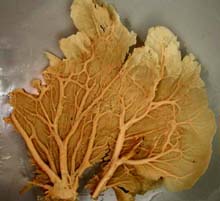Stetson’s Reef Revisited
August 22, 2002
John Reed, Senior Scientist
Division of Biomedical Research
Harbor Branch Oceanographic Institution
Nearly 25 years ago, when I first began studying deep-water reefs, I poured through the scientific literature to learn everything I could about them. I remember coming across a paper by Thomas Stetson from 1962, describing an incredible region, 130 miles southeast of Charleston, S.C., comprising hundreds of deep-water pinnacles and reefs, some up to 480 feet tall. He only knew them from echo soundings made in the 1950s, and he used a bottom grab, pipe dredge, and a camera dropped on a line from the surface to describe these features. Amazingly, since then no one has had the opportunity to see these amazing deep-water reefs in person until this week, with NOAA’s Ocean Exploration funding and Harbor Branch Oceanographic Institution’s Johnson-Sea-Link submersible.
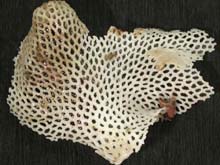
Deepwater lacy bryozoan. Click image for a larger view.
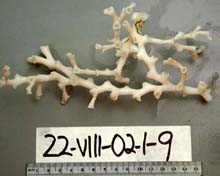
Lophelia sp. deepwater coral. Click image for a larger view.
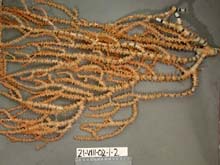
A bamboo coral (Ceratoisis flexibilis) with living polyps. Click image for larger view.
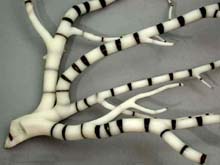
A bamboo coral skeleton (Ceratoisis flexibilis) with living tissue removed. Click image for larger view.
In the past four days we have zigzagged continuously across one small, 10 x 10 mile area, with the ship’s fathometer. During these transects we have recorded every few seconds the depth, latitude, and longitude in order to make a 3-dimensional map of this site. Considering that this region of deep-reef pinnacles covers over 1,500 square miles, we can see how little we know of the ocean bottom. Finally, we pinpointed a 500 ft tall reef pinnacle, which we have concentrated on these past few days. Two days ago when I made the first dive on this underwater pinnacle, we had very little current and could see about 30 ft in front of the submersible; of course, it is pitch black to our eyes at that depth so we can only see as far as the submersible's lights. As we made our way up from 1/2 mile deep at the base of the pinnacle, the rocky slope got steeper and steeper until near the top, where it has huge rock boulders and a vertical rock wall that are covered with bushes of live Lophelia coral, sponges, sea plumes, and 3-ft tall black coral bushes. As we came over the edge of the peak at 2,000 ft deep, we discovered a flat plateau as far as we could see. Every square foot of the bottom on this plateau is covered with fan shaped sponges, corals, sea plumes, and other animals. It is truly an oasis in a world alien to humans.
We are making one more dive on this deep reef site today, hopefully landing the submersible directly on top of this narrow peak, 2,000 feet deep. The first day here there was only about a 1-knot current flowing at the bottom the first day we arrived at this site, but yesterday and today it picked up to 3.5 knots on the surface and 1 knot on the bottom, making it a bit tricky to land the submersible on the target site. It's like a hot air balloon being blown by the winds trying to land on a tiny mountain top peak. But we want to make the most of our last dive and spend the entire time on the plateau on top. Here is where we have found the greatest diversity of life so far which we hope to characterize with video, photographs, and museum specimens. This is true exploration, which is so rare in today’s world of science. And perhaps, as we test some of these specimens for novel chemical compounds, we may discover some new cure for human diseases, such as cancer.
Sign up for the Ocean Explorer E-mail Update List.















































